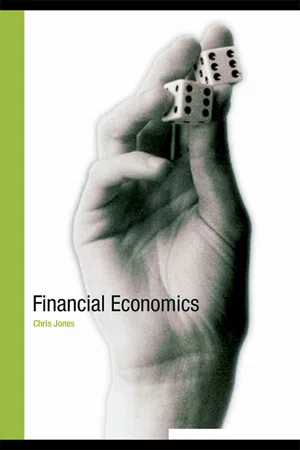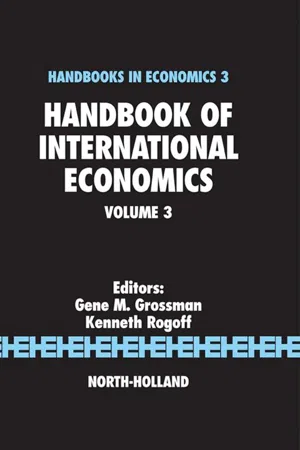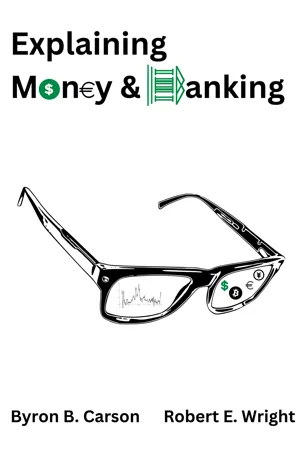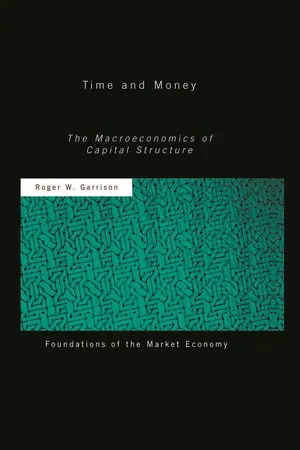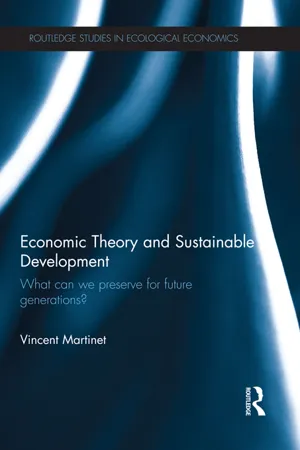Economics
Intertemporal Trade
Intertemporal trade refers to the exchange of goods or services between different time periods. It involves making decisions about consumption and investment over time, taking into account factors such as interest rates, inflation, and future expectations. Intertemporal trade is an important concept in macroeconomics and finance.
Written by Perlego with AI-assistance
Related key terms
Related key terms
1 of 4
Related key terms
1 of 3
6 Key excerpts on "Intertemporal Trade"
- eBook - ePub
- Chris Jones(Author)
- 2008(Publication Date)
- Routledge(Publisher)
2The role of trade is examined in Section 2.2 by introducing it in stages. Atemporal trade is introduced to the autarky economy where consumers exchange goods in each time period but not over time. This first step conveniently allows us to summarize intertemporal consumption choices using dollar values of expenditure in each period. It is the basis for the standard Fisher (1930) analysis of intertemporal consumption choices over current and future expenditure. Since consumers equate the marginal utility from spending (real) income on each good in their bundle, the composition of the consumption bundle can be suppressed in the analysis. Fiat money (currency) is then included to identify its role as a medium of exchange, and we do this by initially ruling out currency as a store of value, where the demand for currency is determined by its ability to reduce trading costs in each time period. The final extension allows consumers to also trade across time periods in a market economy, where some save while others borrow due to differences in their preferences, income flows and /or the rate of interest (which equates aggregate borrowing and saving in a competitive capital market). These intertemporal transfers can be made without affecting aggregate consumption. It only requires consumers to have different marginal valuations for future relative to current consumption. And there is even greater scope to trade intertemporally when aggregate consumption can be transferred into the future through storage and other forms of investment.Financial securities play a number of important roles in market economies, one of which is to reduce the costs of trading private property rights over resources. Most finance models ignore these costs because they are relatively small, but that diminishes their importance, particularly when there is uncertainty and asymmetric information between traders where property rights are more costly to trade. In a certainty setting with complete information, no transactions costs, and perfectly divisible capital goods, there is no role for financial securities. In reality, however, goods are not perfectly divisible and they are costly to move about, and financial securities, and in particular fiat money, can dramatically lower these costs by reducing the number of physical exchanges of goods and services. Without financial assets consumers would exchange goods numerous times before finally converting them into their preferred consumption bundle. Since these assets provide holders with claims to underlying real resources, they reduce the number of times goods are transferred between consumers. When financial securities trade in a market economy we refer to it as an asset economy - eBook - ePub
- G.M. Grossman, Kenneth Rogoff(Authors)
- 1997(Publication Date)
- North Holland(Publisher)
Instead, the intertemporal approach emphasized the response of forward-looking individuals to the changes in lifetime consumption possibilities that terms-of-trade movements cause. The simplest case is of a specialized economy with an exogenous endowment Y of its export good, but which also consumes imports. As in the model with nontradeables, we again assume an isoelastic period utility function defined over a CES index C ; here it depends on the individual's consumptions C M of imports and C x of exports: C = [ α 1 / ρ C M (ρ − 1) / ρ + (1 − α) 1 / ρ C X (ρ − 1) / ρ ] ρ / (ρ − 1) Let p now denote the price of exports in terms of imports, which is determined exogenously in the world market. The consumption-based price level in terms of imports is again denoted by P and given by formula (3.18). The natural benchmark case, assumed by Svensson and Razin (1983), supposes that Intertemporal Trade is done through bonds indexed to the consumption index, C. In this case r is the own rate of interest on the consumption index, and the budget constraint corresponding to (3.3) in the present setup (abstracting from investment and government) is ∑ s = t ∞ R t, s C s = (1 + r t) A t + ∑ s = t ∞ R t, s (p s Y s P s) The Euler equation for the consumption index is again (3.7), implying the consumption function corresponding to (3.8), which has I = G = 0 and pY / P in place of Y. To focus on the terms of trade, it is helpful to assume that r = (1 − β)/ β and Y are constant, in which case the consumption function reduces to: C t = r A t + r 1 + r ∑ s = t ∞ (1 1 + r) s − t (p s Y P s) A fall in the terms of trade lowers p (the relative price of exports in terms of imports) relative to P (the overall CPI in terms of imports). Thus, fluctuations in the terms of trade affect the consumption index and the current account (which here is measured in consumption-index units) exactly like fluctuations in GDP at constant terms of trade - Gideon Keren, George Wu, Gideon Keren, George Wu(Authors)
- 2015(Publication Date)
- Wiley-Blackwell(Publisher)
5 The Psychology of Intertemporal Preferences Oleg UrminskyUniversity of Chicago, Booth School of Business, USAGal ZaubermanYale University, Yale School of Management, USAIntroduction
Intertemporal decisions involve relative preferences and trade-offs for costs and benefits that occur over time. These decisions are ubiquitous and have been extensively studied across multiple academic disciplines, including economics, psychology, business, and public policy. Common examples of such decisions include whether to consume today (i.e., borrow more and/or save less) but have less in your retirement fund; to purchase a cheaper refrigerator or air-conditioning unit but forgo the ongoing energy savings; to hire an experienced employee who can start immediately instead of the brilliant but inexperienced recent graduate who needs more extensive training; or to eat that fatty chocolate cream dessert rather than the blueberry sorbet, increasing your current enjoyment while increasing the risk for your long-term health.Research on this question has occupied the pages of many journals and produced multiple highly influential papers (Ainslie, 1975; Fisher, 1930 Frederick, Loewenstein, & O’Donoghue, 2002; Kirby, Petry, & Bickel, Laibson, 1997; Thaler, 1981). The seminal paper on time discounting by Ainslie (1975), which drew a link between findings from the animal behavior literature and a detailed theory of shifting time preferences, self-control, and precommitment, spurred a large and evolving research literature.Numerous previous chapters have surveyed the field. Loewenstein (1992) provides a detailed account of the development of thinking about intertemporal choice within economics. Frederick, et al. (2002) present a detailed review and discussion of the development of the literature on time discounting in both psychology and economics. Baron (2007) offers a general review of decisions involving time, while Read (2004) and Killeen (2009) review alternative mathematical forms of discount functions. Recently, there have been reviews focusing on the neurological underpinning of intertemporal decisions (e.g., Kable, 2013).- eBook - ePub
- Byron B. Carson, Robert E. Wright(Authors)
- 2023(Publication Date)
- Business Expert Press(Publisher)
Here is another way to consider time preference. Imagine your favorite social media influencer tells you the world is ending in 24 hours and you believe the message. What would you do? What would other people do? We should expect that with so little time, people would prefer consumption today rather than tomorrow. Indeed, whatever people might consume or whatever plans they might make after tomorrow would become much less valuable. This is a situation where your time preference has become very high and you prefer immediate rather than delayed satisfaction.Spot Transactions Are Nice, But Intertemporal Transactions Are NicerTo develop our intuition about time preference and interest, first think about spot transactions. Many of the day-to-day transactions we make, for example, like paying for groceries on the spot, are spot or immediate exchanges. Spot transactions reduce the chance for fraud as both parties have a fairly good idea of what is being exchanged. Also, the goods and money are exchanged simultaneously. The downside of spot transactions is that goods received must be consumed soon thereafter. That is, you wouldn’t buy on the spot market today a box of cereal to eat in one year; that would be some stale cereal. But you might contract today to buy that cereal in a year in what is called the forward market.Many people—for many centuries—have realized they might want to acquire goods today and pay later. Or they might provide goods today and accept payment later. Both are examples of what is termed the credit market.Credit markets have nothing to do with being lazy, a cheat, or poor. Or a greedy lender. Intertemporal exchanges are common, valuable components of economic activity, and make both parties to an exchange better off. Think about cases where you have paid for a good for which the benefits of that good accrue later, for example, the roofing of a house might take a couple days to install, but it provides shelter for years, student debtors receive education over the short term and pay the loan over a longer period, and homeowners buy a house and pay a mortgage. These are intertemporal exchanges.These kinds of exchanges make for distinct problems because time is now a factor; time raises the potential for a different kind of opportunity cost as well as risk. The opportunity cost of lending, for example, refers to the forsaken value of opportunities that could have been pursued over the period of the loan. Similarly, the risk of appropriation becomes more important as time separates the point at which a person receives a good and the point at which a person pays (or is paid). - eBook - ePub
- Roger W Garrison(Author)
- 2000(Publication Date)
- Routledge(Publisher)
Changes in technology and resource availabilities give rise to permanent, or sustainable, changes in the economy’s growth path. Sustainable growth can also be set in motion by changes in intertemporal preferences. Our framework is well suited to trace out the consequences of such a preference change. It is convenient simply to hypothesize an autonomous economy-wide change in intertemporal preferences: people become more thrifty, more future oriented in their consumption plans. In reality, of course, intertemporal preference changes are undoubtedly gradual and most likely related to demographics or cultural changes. For instance, baby boomers enter their high-saving years. Or increasing doubts about the viability of Social Security cause people to save more for their retirement. Or education-conscious parents begin saving more for their children’s college years. The essential point is that intertemporal preferences can and do change and that these changes have implications for the intertemporal allocation of resources.The assumption underlying labor-based macroeconomics is that there is a high degree of complementarity between consuming in one period and consuming in the next. On the basis of this assumption, it is believed, changes in intertemporal preferences can be safely ruled out of consideration. By contrast, capital-based macroeconomics allows for some degree of intertemporal substitutability of consumption. Rejecting the assumption of strict intertemporal complementarity does not imply – as Cowen (1997: 84), for one, suggests that it does – that the actual changes experienced are frequent and dramatic. Quite to the contrary, the claim is that over time even small changes have a significant and cumulative effect on the pattern of resource allocation. More pointedly, capital-based macroeconomics suggests that if the interest rate reports a small change when none actually occurred (or fails to report a small change that actually did occur), the consequences can be cumulative misallocations that eventually lead to a dramatic correction.In Figure 4.2 an increase in thriftiness – in people’s willingness to save – is represented by a rightward shift in the supply of loanable funds. The implied decrease in current consumption is consistent with a change in the intertemporal pattern of consumption demand: people restrict their consumption now in order to be able to consume more in the future. The implication of higher consumption demand in the future was expressed in Chapter 3 - eBook - ePub
Economic Theory and Sustainable Development
What Can We Preserve for Future Generations?
- Vincent Martinet(Author)
- 2012(Publication Date)
- Routledge(Publisher)
r should be rejected since they are dominated by lending in the capital market. The implication is that consumers should make Intertemporal Trade-offs so that their marginal rate of time preference equals the interest rate. Furthermore, consumers should be consistent in their intertemporal choices. The discount rate used should be constant across situations and over time.However, in practice, individuals often have discount rates larger than the market interest rate. An example related to environmental issues is the purchase of household appliances: many people fail to buy more expensive energy-efficient items, even if the extra cost is covered by savings of energy costs in a short time. It is also often the case to “observe” different discount rates for different choices that one individual makes.10This implies some kind of preference for the present. I now examine the consequence of such time preferences on the sharing of consumption over time.3.2.2 Sharing consumption between two periods with time preferences
To illustrate the consequences of time preferences, we shall consider a simple example, in the spirit of the one used in section 3.1.1. The general problem is the same as before. An agent has to share one unit of consumption between two time periods, such that c1 + c2 = 1. However, the agent has time preferences and does not give the same weight to the utility in both periods. The intertemporal welfare is given by the weighted sum of utilities:W(= U)c 1,c 2(+c 1)1U1 + δ(,c 2)where 1/(1 + δ) is the discount factor, δ being the discount rate. The discount factor represents the way the agent values the utility of the second period before taking the consumption decision in the first period. If δ = 0, the discount factor is equal to one and the two periods have equal weight. If δ > 0, the discount factor is lower than one and the weight of the second period utility is lower than that of the first period. The agent has a preference for the present. On the contrary, δ <
Index pages curate the most relevant extracts from our library of academic textbooks. They’ve been created using an in-house natural language model (NLM), each adding context and meaning to key research topics.
Explore more topic indexes
Explore more topic indexes
1 of 6
Explore more topic indexes
1 of 4
